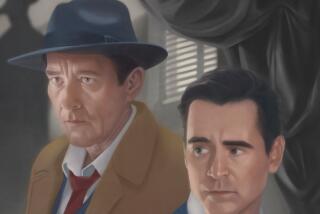The Foul and the Fragrant: ODOR AND THE FRENCH SOCIAL IMAGINATION by Alain Corbin (Harvard University: $25; 307 pp.)
- Share via
Reigning queen of Parisian society Josephine de Beauharnais captured young Napoleon’s heart by conquering his nose. Or so the story goes. In postscripts to letters from Italy and Egypt announcing his return to France, the general, filled with breathless anticipation, admonished Josephine not to bathe. Like his contemporary, Casanova, Napoleon knew that the erotic smells of sex were deadened by frequent washing; Josephine’s natural odors, enlivened by a sprinkle of animal scent manufactured from the abdominal sac of a musk deer, was the intoxicating stuff of Napoleonic dreams.
In the measured, scientific tones of the social hygienists who are the principal actors in his story, Alain Corbin examines odors of the body and other smells, foul and fragrant. For Corbin, Napoleon’s obsession is a prime example of “olfactory sensuality.”
A historian of the French provinces and of French prostitution, Corbin is a distinguished member of “Annalistes”--scholars like Emmanuel Le Roy Ladurie and Maurice Agulhon who are affiliated with the journal Annales and whose aim it is to move beyond celebrated events to probe the “total history” of civilizations. Studies of birth rates, death rituals, war monuments and, now, smells have eclipsed traditional narrative histories of battles, dynasties and institutions. The emperor’s nose holds more interest than Waterloo. And American historians of France are showing no less interest in the common-place: Eugen Weber’s recent “France, Fin de Siecle” is a delightful journey through the belle epoque that spends more time with bicyclists and liver-ailment curists than it does with Emile Zola or Captain Dreyfus.
In Corbin’s history of odor, a “perceptual revolution” began in the 18th Century when “scientists passionately collected, decanted, confined, and preserved ‘airs’--also called gases--and located the effects of each on the animal organism.” That passion was part of a larger Enlightenment enthusiasm for taxonomy; along with the flora and fauna of Buffon and Lamarck, smells were carefully categorized.
Directing noses and notebooks to miasmas emanating from ships, prisons and hospitals (above all in Paris, the “center of stench”), scientists recorded the many forms of putrefaction and, in the process, developed a keen “olfactory vigilance.” Poisonous smells rising from gutters, cesspools and polluted rivers attracted the attention of planners concerned with the safety and efficiency of the city: Health administration, notes Corbin, “was built upon a catalog of noxious odors.”
Smells were classified, but not yet by class. Eighteenth-Century scientists showed little interest in distinctions between the smells of the rich and poor. The shift from “biological” to “social” preoccupations with odor comes in the 19th Century, and, for Corbin, it is a moment of profound change.
As an increasingly “deodorized bourgeoisie” retreats into the purity of private space, the organic odors, the animal scents, that had once permeated the musky boudoirs of the rich and famous, become associated with the great unwashed, with the “foul-smelling masses” of urban and rural poor. Drawing on vast evidence, much of it new, from urban planners, poets, novelists and politicians, Corbin argues an old point: Nietzsche considered odor an important barometer of social demarcation, and the more sympathetic George Orwell later called smell “the real secret of class distinctions in the West.” After all, much of our vocabulary of evil and intolerance ( Mephistophelian , obnoxious ) can be traced to the prejudices of the nose.
At once encyclopedic and impressionistic, “The Foul and the Fragrant” is as elusive as the perfumes and poisons drifting across Paris. A masterful exposition of odors and the perceptions of odors from 1750 to the “Pasteurian revolution” of the late 19th Century--decades during which industrial pollution replaced excrement in the “hierarchy of repulsion”--Corbin’s account rarely moves beyond science and social hygiene to enter, for example, the incense-filled churches of Paris and its provinces or the livestock-filled hovels of French mountain dwellers. Forays into the theoretical social “discourse” of Michel Foucault and his followers add more jargon than clarity, and the author’s prose is not well served by a committee of three translators.
But if, in the end, it is an uneven journey through the history of odor and the French social imagination, it is an important and, at times, fascinating voyage nonetheless. Exploring with imagination and audacity the changing role of smell in the anxieties and antagonisms of the modern world, Corbin reminds us that social history, too long sanitized and too often abstract, must make room for the senses.
More to Read
Sign up for our Book Club newsletter
Get the latest news, events and more from the Los Angeles Times Book Club, and help us get L.A. reading and talking.
You may occasionally receive promotional content from the Los Angeles Times.










